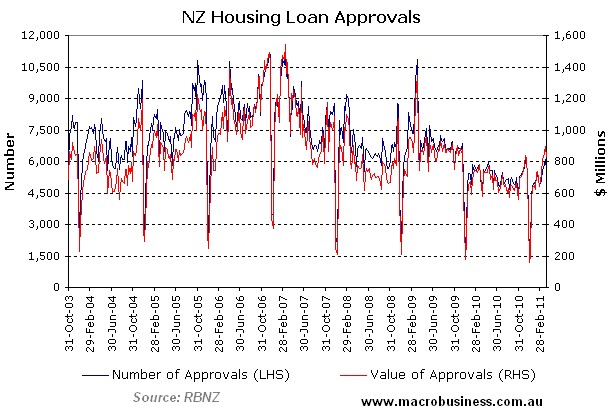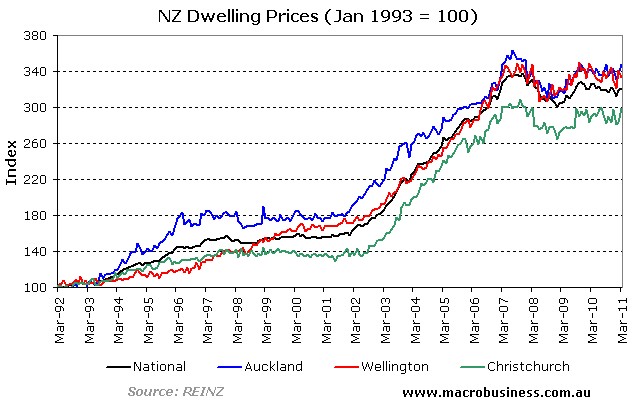
Earlier this month, I wrote about two policy actions being undertaken by the Reserve Bank of New Zealand (RBNZ) and the New Zealand Government aimed indirectly at reducing the economy’s exposure to the housing market. These measures included:
- the Open Bank Resolution (OBR) Policy, which seeks to protect taxpayers from funding future bank bailouts; and
- directing the Productivity Commission (modelled on the Australian body) to undertake an examination into housing affordability, with the stated aim of reducing the economy’s accumulation of debt and exposure to external shocks.
Late last month, the RBNZ also announced that it had identified several macro-prudential tools, such as loan-to-value ratio (LVR) restrictions and counter-cyclical capital buffers, that it would consider using in order to moderate future credit bubbles.
RBNZ Governor, Alan Bollard, said the following about the proposed measures in a recent speech to the Basel III Conference in Sydney:
“[New Zealand needs] to keep preparing for how we might deal with credit and asset price booms when they recur in the future,” Bollard says. “Our work so far on macro-prudential instruments suggests that we should keep our expectations modest, but we have identified several tools that we would contemplate using in the right circumstances.”
He notes past “periods of unsustainably strong credit growth and asset price cycles” which have had damaging effects on the economy and the financial system.
“We will certainly face similar developments in the future, so we want to develop our macro-prudential toolkit now to enhance our ability to deal with them when the time comes,’ says Bollard.
Rapid credit and asset price growth had amplified general economic cycles and made monetary policy’s task of controlling inflation more difficult.
“We have seen the difficulties that can arise when interest rates alone are used,” Bollard says.
“The collateral damage to the net export sector from the high New Zealand dollar exchange rate during the previous economic upswing prompted a search for potential tools to assist monetary policy. Now, in light of the broader and significant social and macroeconomic costs arising from financial system distress in the aftermath of the global financial crisis, there is greater will to consider additional tools.”
The RBNZ appears to have won bipartisan support for the proposed macro-prudential tools.
The Finance Minister of the National Party Government, Bill English, last week made the following comments about the proposed measures:
Finance Minister Bill English says he is satisfied with the Reserve Bank of New Zealand’s consideration of new tools to control property and asset price cycles so there is no repeat of the house price bubble seen during the last decade…
“We don’t want to see a repeat of the 2000s with excessive property speculation. I don’t think that either domestic or overseas banks are going to allow that to happen, because they’ve had a near death experience themselves, and they’d be reckless to go out and lend strongly against property speculation,” English said .
“I think you’ll find that the regulators like the Reserve Bank are keen to make sure that they reduce that prospect as well,” he said.
“The Reserve Bank is a bit ahead of the international pack, it’s been thinking through the issues of what they call macro-prudential regulation, which is, to deal precisely with property cycles that disrupt the macro economy, and they’ve disrupted it pretty severely in this last round.”
“I’m satisfied they are, by international standards, well ahead of most regulators in thinking through how to handle property cycles, and asset [price] cycles,” English said.
For their part, the Labour Opposition today also signalled their support for the proposed measures:
Government needs to look at new tools for the Reserve Bank to use for controlling inflationary pressures, such as regulating loan to value (LVR ) ratios, Labour Party leader Phil Goff said in a speech today…
“We cannot afford to damage our export and productive sectors by policies which promote inflationary housing booms which in turn push up interest and exchange rates,” Goff said.
“That requires leveling the playing field in terms of not creating tax advantages for property investment over the export economy. It means widening the objectives of the Reserve Bank,” he said.
“We need to look at other tools for the Reserve Bank such as regulating the capital to lending ratios to curb inflationary pressure and not just for prudential supervision.”
However, whilst the Government and Opposition are busy agreeing with each other on the need for new macro-prudential measures in order to prevent housing bubbles and spur New Zealand’s export and productive sectors, the RBNZ’s recent 50 basis point cut to official interest rates (to 2.5%) combined with a relaxation of credit standards by the banks, appears to be having the opposite effect of providing renewed fuel to the housing market:
Reserve Bank of New Zealand statistics released on Wednesday show there were NZ$896 million worth of mortgage approvals by banks in the week to April 1.
This was highest level of approvals by value since the week to November 20, 2009…
This is the first rise from a year ago since January 2010.
Mortgage approvals picked up substantially in the wake of the Reserve Bank’s decision to cut the Official Cash Rate by 50 basis points to 2.5% on March 10…
Meanwhile, mortgage brokers report banks have significantly loosened their lending criteria in recent months, increasing maximum loan to value ratios to 95% or higher and allowing larger multiples of lending to income.
Legal fees and other fees are also being dropped as banks strive to revive their lending growth in the wake of a long period of flat to no growth.
Average loan sizes are also larger.
The recent surge of housing loan approvals is evident by the below chart, although approvals are still well below their decade average.

Similarly, although New Zealand’s home prices have rebounded 3% over the past two months, they are still 5% below their November 2007 peak (or around 15% lower in inflation-adjusted terms):

What is most disconcerting about the recent drop in lending standards is that it is New Zealand’s state-owned bank – Kiwibank – that appears to be leading the charge:
Kiwibank has announced a new 6 month mortgage special of 5.40% until the end of April…
This is a record low mortgage rate offered by Kiwibank since it launched nine years ago…
Kiwibank’s 5.40% rate is the lowest in the market except for HSBC, which offers a 4.99% deal to ‘Premier’ customers who borrow more than NZ$500,000 and buy insurance through HSBC.
[Kiwbank CEO, Paul] Brock told Interest.co.nz in a double shot interview with Gareth Vaughan last month it was borrowing hundreds of millions of dollars offshore from the European Commercial Paper or ‘hot money’ markets at 90 day terms.
So on the one hand, you have the New Zealand Government saying that it wants to lower foreign debt and re-balance the economy away from housing speculation towards the export and productive sectors. Whilst at the same time, the Government-owned Kiwibank is worsening New Zealand’s vulnerability to ‘hot’ foreign debt by borrowing hundreds of millions in order to reflate the housing market.
Another flaw in the Government’s policy making is that it is not examining ways to address the other key cause of its housing bubble – i.e. the highly restrictive land-use policies that prevents low-cost housing from being quickly and efficiently supplied to the market, thus ensuring that:
- extra credit demand automatically feeds into higher prices instead of new construction;
- the house price rises and perceived scarcity encourages speculative demand and ‘panic buying’ from first-time buyers, which helps to drive prices up even further; the combination of which
- acts to make New Zealand’s housing market not only less affordable, but also more volatile and prone to boom/bust cycles as demand rises and falls.
To their credit, at least the New Zealand authorities are seriously examining ways to reduce their country’s macroeconomic vulnerabilities. This is in stark contrast to Australia, whose authorities are yet to publicly acknowledge that such vulnerabilities even exist.
In this regard, New Zealand is way ahead of the curve in thinking through how to handle the financial stability aspects of housing/credit cycles.
Cheers Leith

